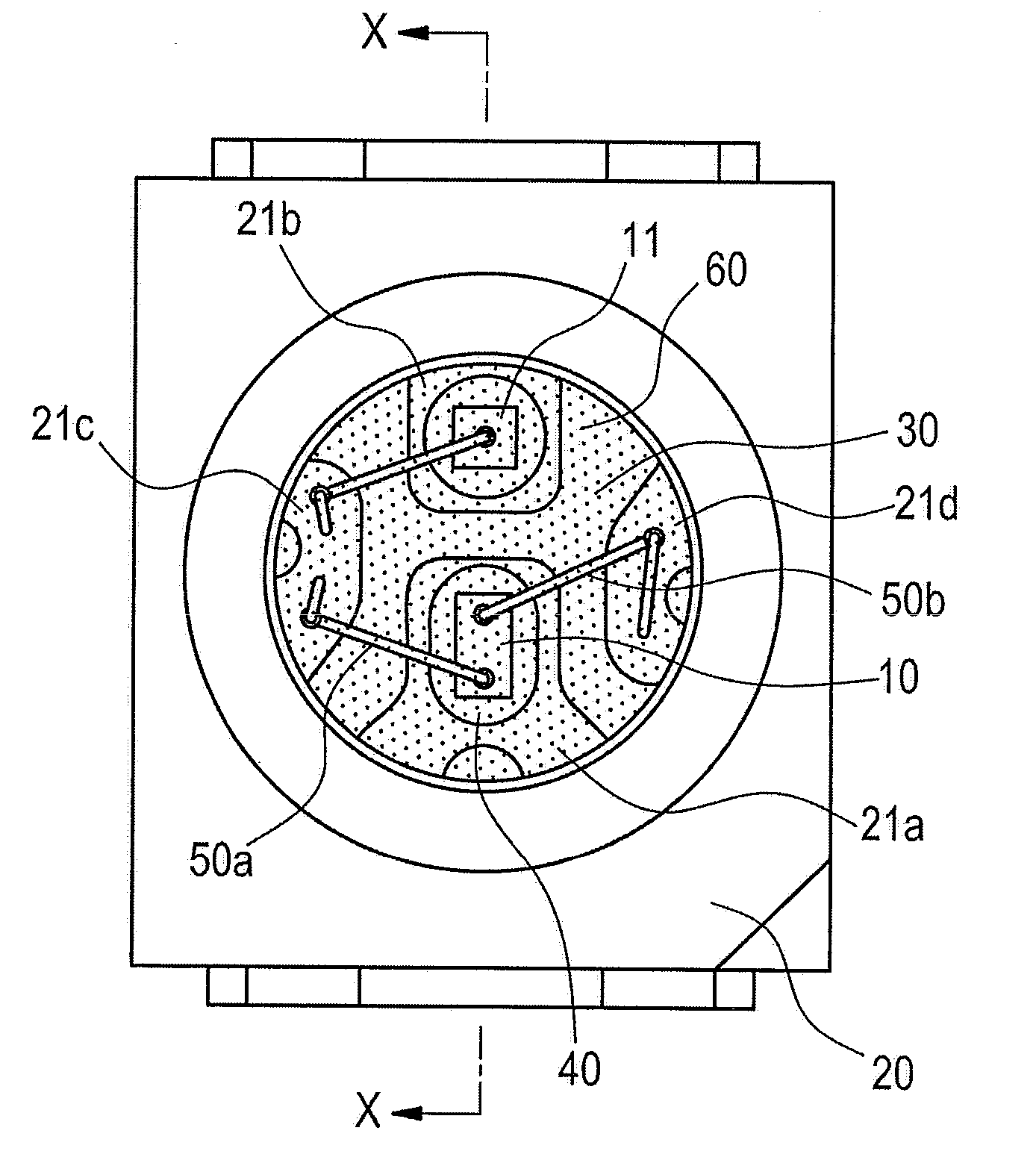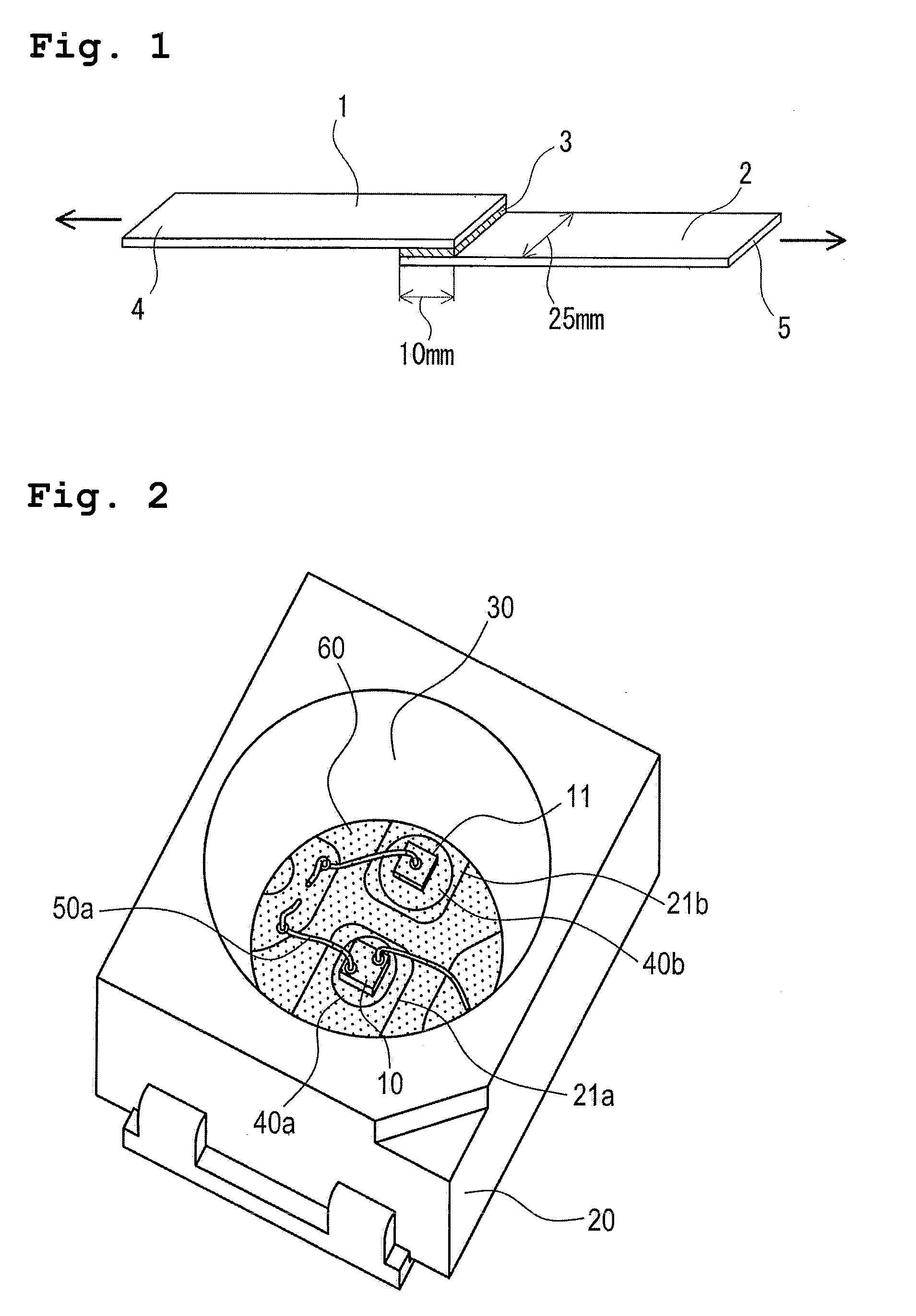Composition encapsulating optical semiconductor and optical semiconductor device using same
a technology of optical semiconductors and semiconductor devices, applied in the direction of solid-state devices, chemistry apparatus and processes, other chemical processes, etc., can solve the problems of unintended bonding, product tack, poor shock resistance, etc., and achieve the effect of reducing surface tack, short process time, and improving production yield and productivity
- Summary
- Abstract
- Description
- Claims
- Application Information
AI Technical Summary
Benefits of technology
Problems solved by technology
Method used
Image
Examples
example 1
[0050]To 87.5 g of a polysiloxane represented by a formula (1) shown below (viscosity at 25° C.: 5,000 mPa·s, hereafter referred to as “VF”):
were added 12.5 g of a resin structure vinylmethylsiloxane (hereafter referred to as “VMQ”) composed of 50 mol % of SiO2 units, 42.5 mol % of (CH3)3SiO0.5 units and 7.5 mol % of Vi3SiO0.5 units (total vinyl group content per 100 g of VF and VMQ in total=0.0162 mols), 1.2 g of an organohydrogensiloxane represented by a formula (ii) shown below:
and 0.6 g of an organohydrogensiloxane represented by a formula (iii) shown below:
thereby providing a total SiH group content equivalent to 1.5 mols per 1 mol of vinyl groups within the combination of the aforementioned VF and VMQ components, 0.05 g of an octyl alcohol-modified ehloroplatinic acid solution (platinum concentration: 2% by mass), and 1.5 g of an oligomer represented by a formula (Iv) shown below:
and the resulting mixture was mixed thoroughly, thereby completing preparation of a composition.
example 2
[0051]With the exceptions of using 70 g of VF and 30 g of VMQ (total vinyl group content per 100 g of both components=0.0310 mols), and using 2.25 g of the organohydrogensiloxane represented by the formula (ii) and 1.1 g of the organohydrogensiloxane represented by the formula (iii) in order to provide a total SiH group content equivalent to 1.5 mols per 1 mol of vinyl groups within the combination of VF and VMQ components, a composition was prepared in the same manner as Example 1.
example 3
[0052]With the exceptions of using 92 g of VF and 8 g of VMQ (total vinyl group content per 100 g of both components=0.0124 mols), and using 0.91 g of the organohydrogensiloxane represented by the formula (ii) and 0.49 g of the organohydrogensiloxane represented by the formula (iii) in order to provide a total SiH group content equivalent to 1.5 mols per 1 mol of vinyl groups within the combination of VF and VMQ components, a composition was prepared in the same manner as Example 1.
PUM
| Property | Measurement | Unit |
|---|---|---|
| viscosity | aaaaa | aaaaa |
| viscosity | aaaaa | aaaaa |
| viscosity | aaaaa | aaaaa |
Abstract
Description
Claims
Application Information
 Login to View More
Login to View More - R&D
- Intellectual Property
- Life Sciences
- Materials
- Tech Scout
- Unparalleled Data Quality
- Higher Quality Content
- 60% Fewer Hallucinations
Browse by: Latest US Patents, China's latest patents, Technical Efficacy Thesaurus, Application Domain, Technology Topic, Popular Technical Reports.
© 2025 PatSnap. All rights reserved.Legal|Privacy policy|Modern Slavery Act Transparency Statement|Sitemap|About US| Contact US: help@patsnap.com



